

The beanpoles are hollow composite-concrete tubes three hundred sixty feet
in length and fifteen feet in diameter. Below the waterline, the cross section
is teardrop-shaped, to reduce drag in Gulf Stream's powerful current. The lowermost
70 feet of each
beanpole is a ballast bulb filled with ferro-concrete. The primary buoyancy chamber
for the beanpole is an oblate spheroid whose largest diameter is 70 feet.
The remaining below-waterline length (230 to 260 feet) is compartmentalized, with
chambers that can be flooded or emptied to change the structure's buoyancy. Because
One of the four modules comprises living quarters, the main mess hall, and the medical center
(Residential module); one is dedicated to labs and offices for onboard and visiting
researchers (Science module); one houses the facility's primary control center, and
also ocean engineering projects, hydrogen production, water desalination, and
wastewater treatment (Engineering module); and the last is occupied by mariculture processing and the facility's
main dive and boat stations (Mariculture module).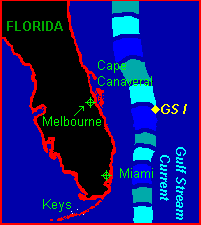 Gulf Stream I is a floating community tethered in three thousand
feet of water one hundred miles off the east coast of Florida on the
eastern edge of the Gulf Stream.
Gulf Stream I is a floating community tethered in three thousand
feet of water one hundred miles off the east coast of Florida on the
eastern edge of the Gulf Stream.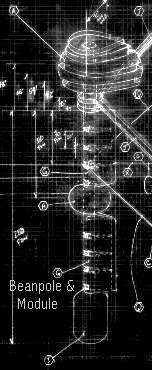 Its living and working spaces consist of four multi-storied
buildings (modules) supported thirty to fifty feet above the water's
surface by four "beanpoles."
Its living and working spaces consist of four multi-storied
buildings (modules) supported thirty to fifty feet above the water's
surface by four "beanpoles." 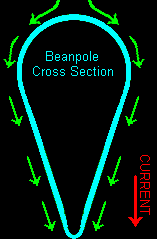 the buoyancy chambers are well below the surface, the structure is immune to
large wave action, remaining stable even in hurricanes. The four
beanpoles are linked above the surface by hinged walkways, flexible
water, power, and sewage connections, and below the water by hinged
beams that hold the beanpoles at a fixed distance apart but let the
different beanpoles float at different heights in the water.
the buoyancy chambers are well below the surface, the structure is immune to
large wave action, remaining stable even in hurricanes. The four
beanpoles are linked above the surface by hinged walkways, flexible
water, power, and sewage connections, and below the water by hinged
beams that hold the beanpoles at a fixed distance apart but let the
different beanpoles float at different heights in the water.  Like the beanpole cross sections, the above-water modules are also
teardrop-shaped to reduce drag. Since the winds shift direction, unlike the Gulf Stream current, the modules
can pivot on top of the beanpoles.
Like the beanpole cross sections, the above-water modules are also
teardrop-shaped to reduce drag. Since the winds shift direction, unlike the Gulf Stream current, the modules
can pivot on top of the beanpoles.
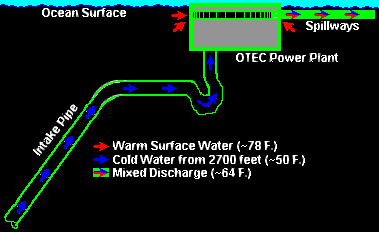
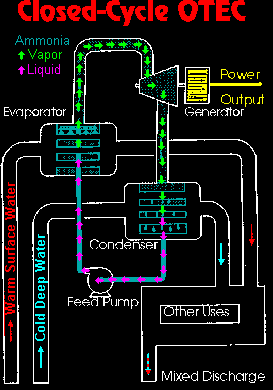 The deep, cold water comes from a mile-long, thirty-foot diameter
plastic pipe which is linked to the main anchor tether of the beanpole
structure. The power plant, which can generate up to 100 Mw of power, net,
was built to handle an expanded community several times the size of the existing
installation.
The deep, cold water comes from a mile-long, thirty-foot diameter
plastic pipe which is linked to the main anchor tether of the beanpole
structure. The power plant, which can generate up to 100 Mw of power, net,
was built to handle an expanded community several times the size of the existing
installation.The community obtains drinking water by a large solar/electric heat desalination plant on the Engineering module's roof. The desalination plant uses heat-driven evaporation to distill sea water. The "sea salt" byproduct is marketed ashore. Sewage treatment is handled on the bottom floor of the module by a series of aeration and clarification tanks. Treated water is mixed with outflow from the "hot" side of the power plant and discharged near the bottom of the beanpole, two hundred eighty feet underwater, and carried away by the current. Biosludge from the aeration and clarification tanks are discharged the same way. Like the power plant, both the desalination and sewage treatment facilities have excess capacity.
Other roof structures include pressurized hydrogen, nitrogen, and ammonia storage; a helicopter landing pad that also serves as a tennis/volleyball court; roof gardens; and communication and meteorological equipment.
Excess electrical power is used to separate hydrogen and oxygen from water using super-acid-membrane electrolytic cells. The hydrogen is stored for transfer and some oxygen is used for diving as well as to increase the efficiency of the wastewater treatment plant. Hydrogen/oxygen welding and cutting torches are also used.
 One property of the deep, cold water from the power plant is
that it is nutrient-rich and will cause a plankton bloom on the
surface, where nutrients enter the realm of photosynthesis. This in
turn will attract plankton-eaters such as brine shrimp and other
macro-organisms, which in turn attract small fish, and bigger fish,
and bigger pelagic fish. While a certain degree is helpful to the facility's
mariculture efforts, this plankton bloom must be carefully controlled, or
it can seriously disrupt the local ecology.
One property of the deep, cold water from the power plant is
that it is nutrient-rich and will cause a plankton bloom on the
surface, where nutrients enter the realm of photosynthesis. This in
turn will attract plankton-eaters such as brine shrimp and other
macro-organisms, which in turn attract small fish, and bigger fish,
and bigger pelagic fish. While a certain degree is helpful to the facility's
mariculture efforts, this plankton bloom must be carefully controlled, or
it can seriously disrupt the local ecology.
Another property of deep, cold water is that it is rich in stored carbon dioxide. To prevent the power plant from releasing as much carbon dioxide as its fossil-fuel-burning counterparts, the seawater outflow runs through a series of transparent-topped spillways where the carbon dioxide nourishes commercial algae production. Carbon dioxide and some of the excess nutrients are tied up.
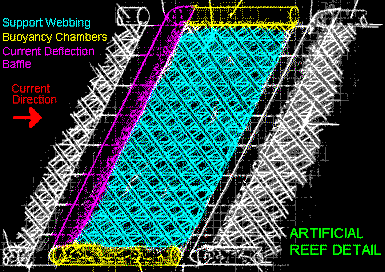 To properly exploit the remaining discharged nutrients, a
floating "reef," twenty to forty feet under the surface and supported
by submerged buoyancy chambers, is moored downcurrent from the
power plant spillway outflow. This reef consists of 100-by-180-foot
rigid frames with nylon webbing between them. In certain reef segments, objects
such as old tires, plastic culvert pipe, and other low-density objects hang
in the webbing providing "niches" of varying size for marine life of varying size.
In others, calcium carbonate piping is grown from seawater and electrical current.
Each of these frames is supported at each side by the chambers and
linked loosely by webbing to adjoining frames.
To properly exploit the remaining discharged nutrients, a
floating "reef," twenty to forty feet under the surface and supported
by submerged buoyancy chambers, is moored downcurrent from the
power plant spillway outflow. This reef consists of 100-by-180-foot
rigid frames with nylon webbing between them. In certain reef segments, objects
such as old tires, plastic culvert pipe, and other low-density objects hang
in the webbing providing "niches" of varying size for marine life of varying size.
In others, calcium carbonate piping is grown from seawater and electrical current.
Each of these frames is supported at each side by the chambers and
linked loosely by webbing to adjoining frames.
 The frames closest to the outflow will be seeded with local cold-water
life forms. Downcurrent, where the cold water mixes more with warm surface
water, more tropical marine life will be seeded. As
frames become heavier, buoyancy is adjusted from Engineering's
control room. When frames become too heavy for this, they will be
"harvested" -- detached from the overall reef and towed to appropriate
coastal waters, to populate or repopulate coastal marine sea
life.
The frames closest to the outflow will be seeded with local cold-water
life forms. Downcurrent, where the cold water mixes more with warm surface
water, more tropical marine life will be seeded. As
frames become heavier, buoyancy is adjusted from Engineering's
control room. When frames become too heavy for this, they will be
"harvested" -- detached from the overall reef and towed to appropriate
coastal waters, to populate or repopulate coastal marine sea
life.
The reef is tethered to the beanpole complex and, as a result, swings with current changes to always be downcurrent from the power plant outflow.
Surrounding the entire complex is an artificial breakwater, tethered to a deep framework (60 feet below the surface). This breakwater consists of thousands of surface buoys that support weighted "water brakes" fifty feet below them. As waves lift individual buoys, the disk-like water brakes resist upward motion, draining energy from the swells with each buoy until the swells that make it into the protected inner circle are a ghost of their former selves.
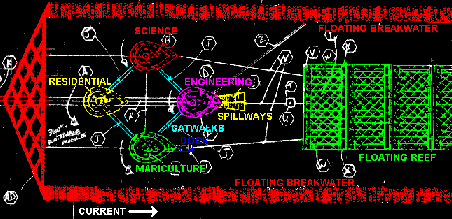
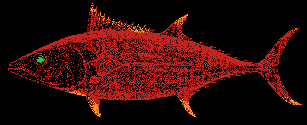 routinely trawls the downstream area and sells its catch in Florida.
The facility's hydrogen storage barges are tethered three hundred yards away from the
beanpole structure and are switched out with each other -- the empty one is
moored at the hydrogen barge station while the full one is towed to market in
Cape Canaveral. There are also two smaller hydrogen burning work boats (La Granjera and
La Auxiliadora), as well as Zodiac inflatables and recreational sail boards.
routinely trawls the downstream area and sells its catch in Florida.
The facility's hydrogen storage barges are tethered three hundred yards away from the
beanpole structure and are switched out with each other -- the empty one is
moored at the hydrogen barge station while the full one is towed to market in
Cape Canaveral. There are also two smaller hydrogen burning work boats (La Granjera and
La Auxiliadora), as well as Zodiac inflatables and recreational sail boards.Other equipment at Gulf Stream I includes 2 rigid "JIM" suits, single-occupant submersibles capable of working in water depths up to one mile. In addition there are two cabled ROVs (Remotely Operated Vehicles): remote-controlled submersibles used for routine inspection of all underwater equipment and structures. Standard scuba gear is used for work in less than 200 feet of water, and mixed-gas diving gear for working in depths up to 400 feet.
Communications are handled internally by VHF marine band radios and internal telephone/intercom. Communications to land are through a microwave telephone relay tying into the Florida Bell System and Gulf Stream landside computer facilites. There's a VHF radio/telephone for backup, a satellite dish for TV, two marine radar sets to detect and warn off marine traffic collisions, and a Satelite GPS set to pinpoint the facility's latitude and longitude as it swings in east and west in eddies of the gulf stream current.